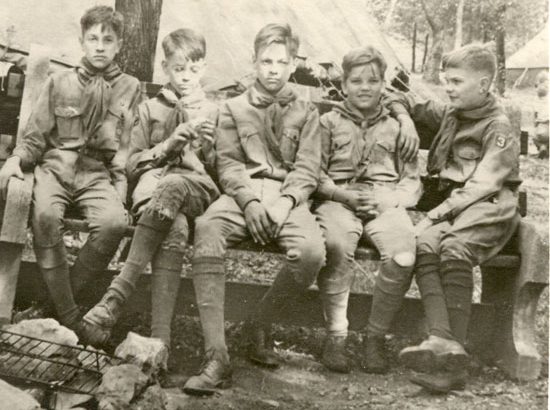All the Red Ties: From Catholic Boy Scouts of Ireland in Donnybrook 1927 to Scouting Ireland 2017
by Dermot Lacey (Carrowmore, €15.00)
The development of Scouting in Ireland was shaped by the major cultural, political and religious traditions in the country. The Irish B-P scouts traced their beginnings to Lieut-General Robert Baden-Powell and the camp he organised at Brownsea Island in Poole Harbour in Dorset in August 1907.
The scouts arrived in Ireland in the following year. It is known that the first scout in Dublin was enrolled on 15 February 1908 in the Wolf patrol of the 1st Dublin troop by the scoutmaster Lieut. R.P. Fortune.
The B-P scouts were promoted and fostered by members of the Anglo-Irish aristocracy and the various Protestant Churches. They also developed close relations with British garrisons in different parts of the country particularly during World War I.
Countess Constance Markiewicz founded Fianna Éireann (the Republican Scouts) in 1909 to counter the Anglicising influence of the B-P scouts. Some of them featured in the Dublin Lock-Out in 1913. Subsequently they were involved in the 1916 Rising, War of Independence and on the anti-treaty side in the Civil War.
They continued to be an integral part of the republican movement throughout much of the 20th Century.
Fr Tom Farrell, with the assistance of his brother, Fr Ernest, promoted the Catholic Boy Scouts of Ireland in 1927 as a Catholic alternative youth movement to the B-P scouts and particularly the Fianna Éireann.
With the support of the Knights of St Columbanus and not least Sir Joseph A. Glynn, troops were quickly established in many of the parishes in the archdiocese of Dublin.
The CBSI had a significant role in stewarding the Eucharistic Congress in 1932. Thereafter the movement spread rapidly throughout the country and they featured at important civil and religious celebrations both locally and nationally.
They acquired their impressive training ground at Larch Hill in Rathfarnham in 1938. During World War II they were involved in with the activities of the Local Defence Volunteers in ‘home guard’ duties.
Dermot Lacey was a life-long member of the Catholic scouts in Donnybrook and later served as Lord Mayor of Dublin.
Account
In his account of the Donnybrook scouts he records the most recent significant developments in scouting in Ireland. Beginning in the early 1970s in isolated cases some girls were allowed to join boyscout troops, in both the Scout Association of Ireland (the B-P scouts) and the CBSI.
By the 1990s co-educational or mixed scouting had arrived in both Associations. Then following intensive consultations and joint meetings the two Associations merged in 2004 and a new title – Scouting Ireland – and new national structures were agreed.
Regrettably, it was not possible at that time to persuade the Northern Ireland Scout Council, which was responsible for the B-P scouts in that jurisdiction, to join the merger.
In his reflections on those developments the author claims that he and the Donnybrook scouts were at the forefront in campaigning for them. However, for the record, it was Fr Denis Costello, Catholic chaplain to Sallynoggin Senior College, who in 1980 founded the first mixed troop in the Republic of Ireland.
Mgr Daniel Moloney founded the Donnybrook scouts in 1927.
Lacey records every aspect of their activities during the subsequent 90 years: the awards, camps, competitions, support of committee members and donors, hikes, meetings, parades and trips abroad, including the antics of some of the troops’ outgoing personalities. He highlights their successful drive to have their own scout hall built and their pride in their exceptional pipe and drum band.
As a former boyscout (4th Kerry CBSI) I warmly welcome this excellent monograph which provides an excellent account of the scouting experience in Donnybrook and is a valuable contribution to the history of scouting in Ireland.



